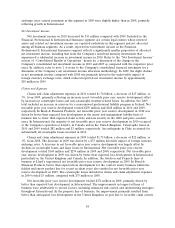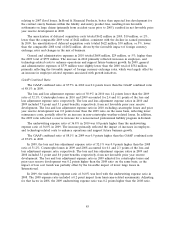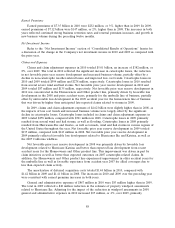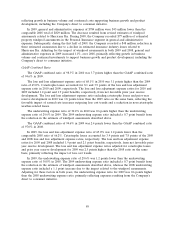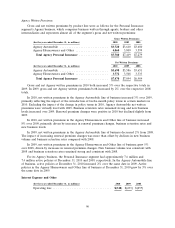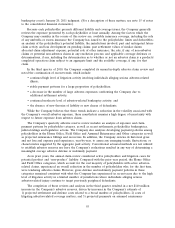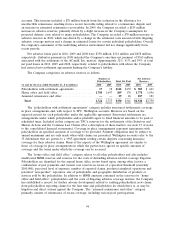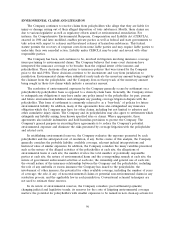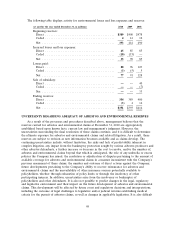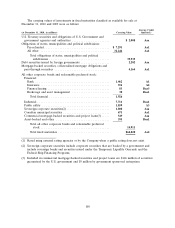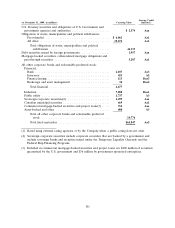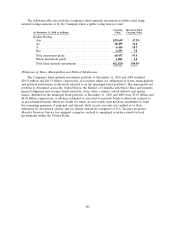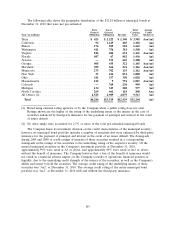Travelers 2010 Annual Report Download - page 106
Download and view the complete annual report
Please find page 106 of the 2010 Travelers annual report below. You can navigate through the pages in the report by either clicking on the pages listed below, or by using the keyword search tool below to find specific information within the annual report.
accounts. This increase included a $70 million benefit from the reduction in the allowance for
uncollectible reinsurance resulting from a recent favorable ruling related to a reinsurance dispute and
an increase in estimated reinsurance recoverables. In 2009, the Company recorded a $185 million
increase in asbestos reserves, primarily driven by a slight increase in the Company’s assumption for
projected defense costs related to many policyholders. The Company recorded a $70 million increase to
asbestos reserves in 2008, which was driven by a change in the estimated costs associated with litigating
asbestos coverage matters and a change in estimated losses for certain individual policyholders. Overall,
the company’s assessment of the underlying asbestos environment did not change significantly from
recent periods.
Net asbestos losses paid in 2010, 2009 and 2008 were $350 million, $341 million and $658 million,
respectively. (Asbestos payments in 2008 included the Company’s one-time net payment of $365 million
associated with the settlement of the ACandS, Inc. matter). Approximately 32%, 41% and 59% of total
net paid losses in 2010, 2009 and 2008, respectively, related to policyholders with whom the Company
had entered into settlement agreements limiting the Company’s liability.
The Company categorizes its asbestos reserves as follows:
Number of Net Asbestos
Policyholders Total Net Paid Reserves
(at and for the year ended December 31, $ in millions) 2010 2009 2010 2009 2010 2009
Policyholders with settlement agreements .......... 17 18 $112 $139 $ 583 $ 621
Home office and field office .................... 1,705 1,697 209 176 1,778 1,956
Assumed reinsurance and other ................. ——29 26 187 181
Total ................................... 1,722 1,715 $350 $341 $2,548 $2,758
The ‘‘policyholders with settlement agreements’’ category includes structured settlements, coverage
in place arrangements and, with respect to TPC, Wellington accounts. Reserves are based on the
expected payout for each policyholder under the applicable agreement. Structured settlements are
arrangements under which policyholders and/or plaintiffs agree to fixed financial amounts to be paid at
scheduled times. Included in this category are TPC’s reserves for the settlements of the Statutory and
Hawaii Actions and the Common Law Claims. (For a description of these matters, see note 15 of notes
to the consolidated financial statements). Coverage in place arrangements represent agreements with
policyholders on specified amounts of coverage to be provided. Payment obligations may be subject to
annual maximums and are only made when valid claims are presented. Wellington accounts refer to the
35 defendants that are parties to a 1985 agreement settling certain disputes concerning insurance
coverage for their asbestos claims. Many of the aspects of the Wellington agreement are similar to
those of coverage in place arrangements in which the parties have agreed on specific amounts of
coverage and the terms under which the coverage can be accessed.
The ‘‘home office and field office’’ category relates to all other policyholders and also includes
unallocated IBNR reserves and reserves for the costs of defending asbestos-related coverage litigation.
Policyholders are identified for the annual home office review based upon, among other factors: a
combination of past payments and current case reserves in excess of a specified threshold (currently
$100,000), perceived level of exposure, number of reported claims, products/completed operations and
potential ‘‘non-product’’ exposures, size of policyholder and geographic distribution of products or
services sold by the policyholder. In addition to IBNR amounts contained in the reserves for ‘‘home
office and field office’’ policyholders and the costs of litigating asbestos coverage matters, the Company
has established a reserve for further adverse development related to existing policyholders, new claims
from policyholders reporting claims for the first time and policyholders for which there is, or may be,
litigation and direct actions against the Company. The ‘‘assumed reinsurance and other’’ category
primarily consists of reinsurance of excess coverage, including various pool participations.
94


